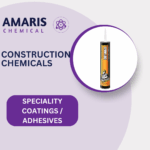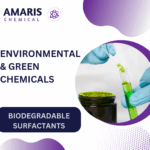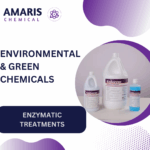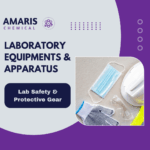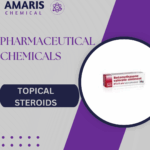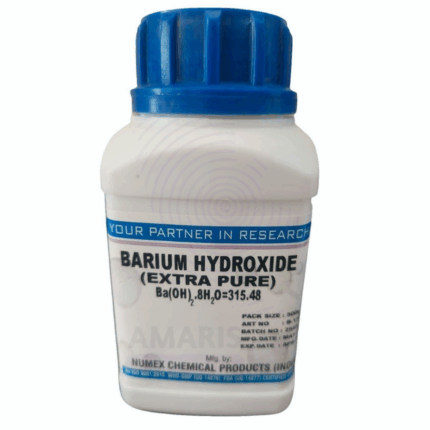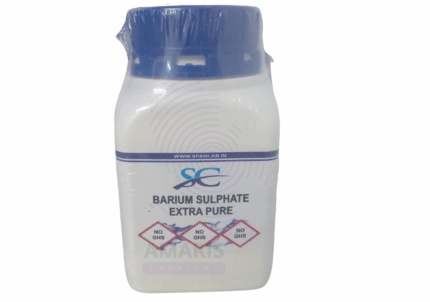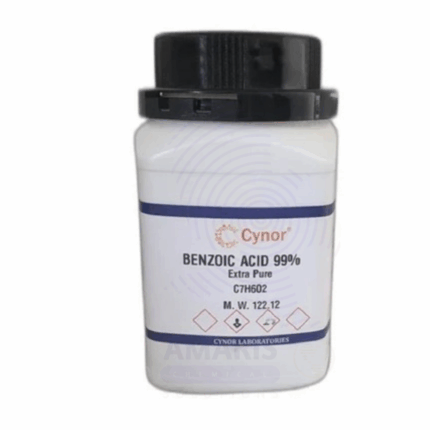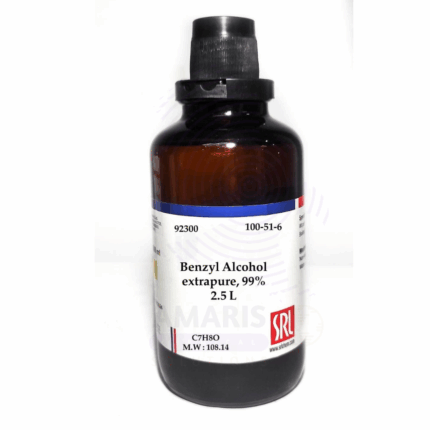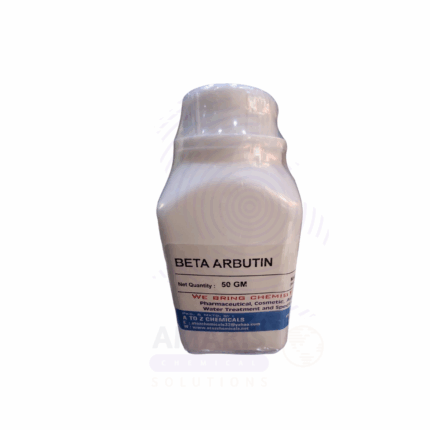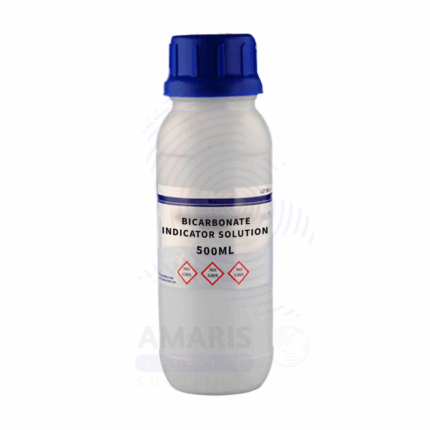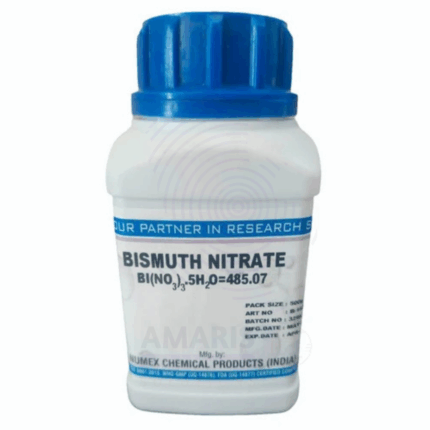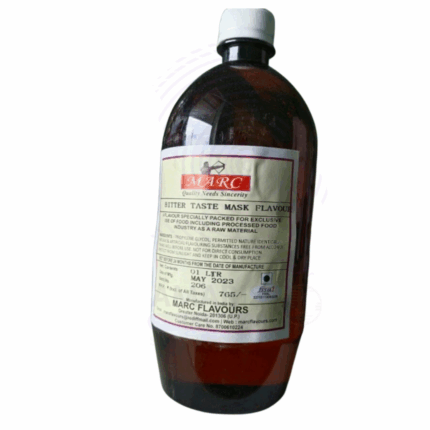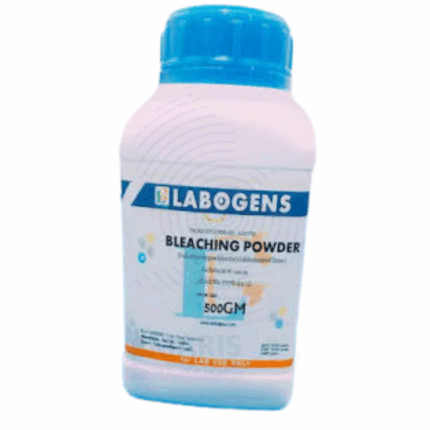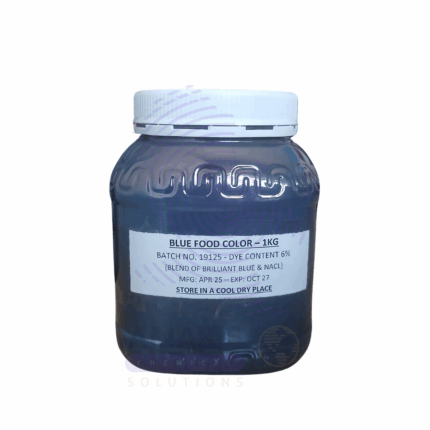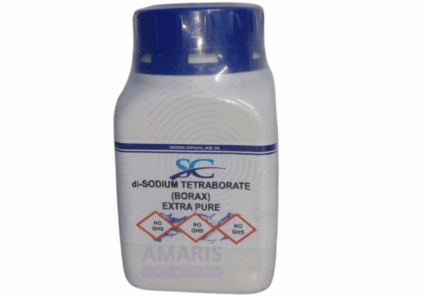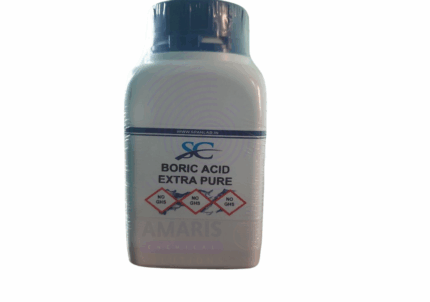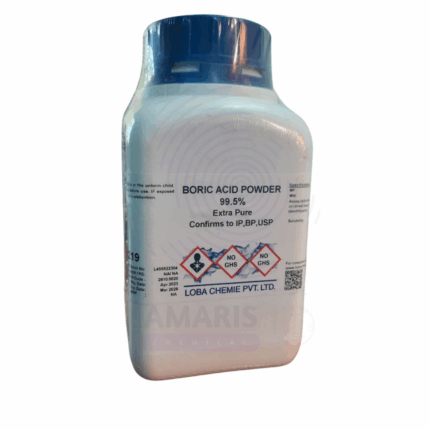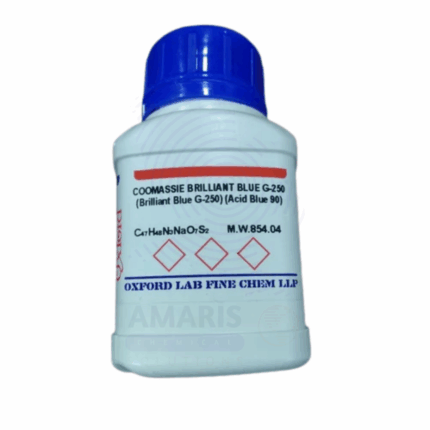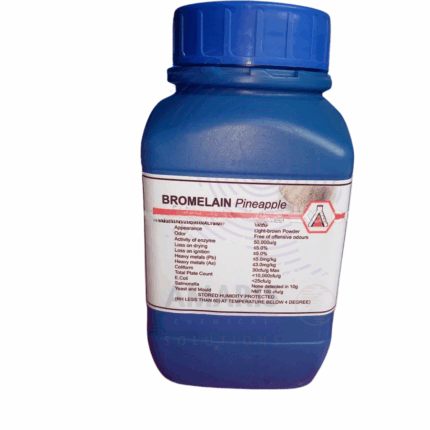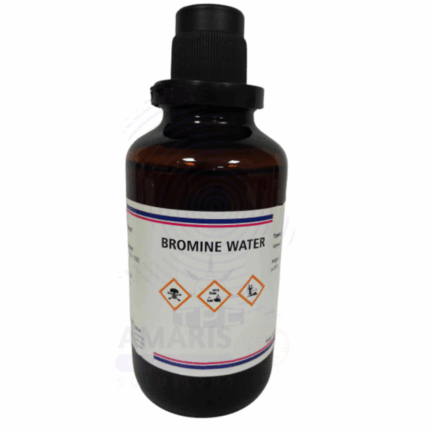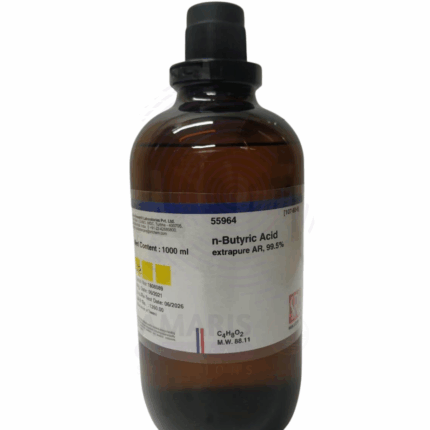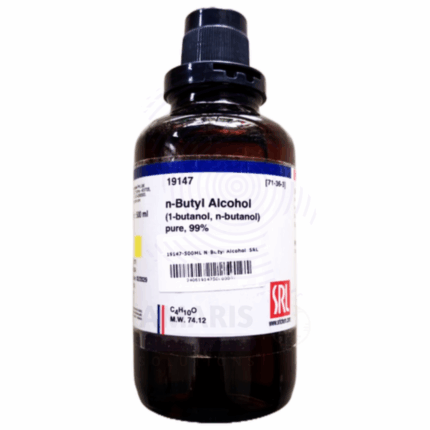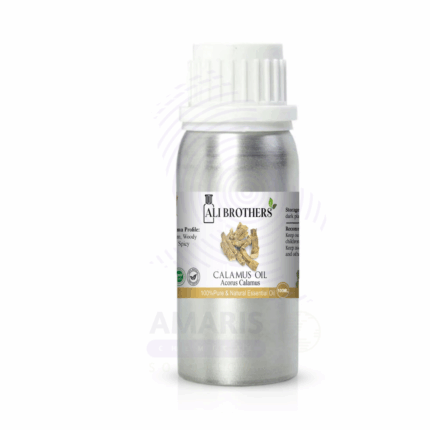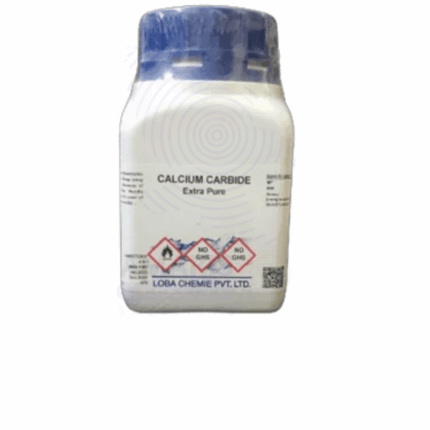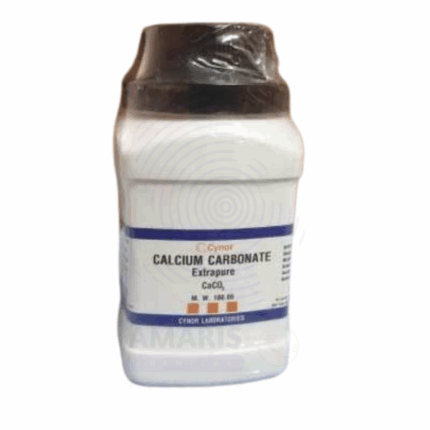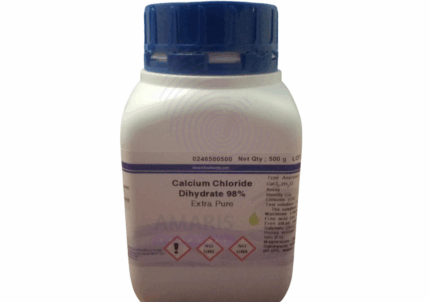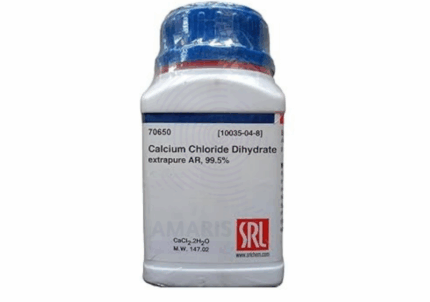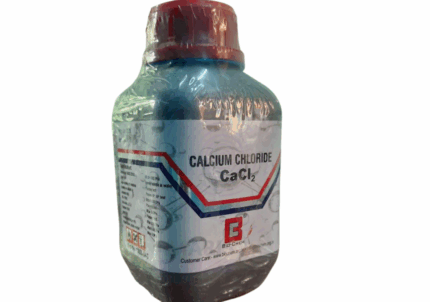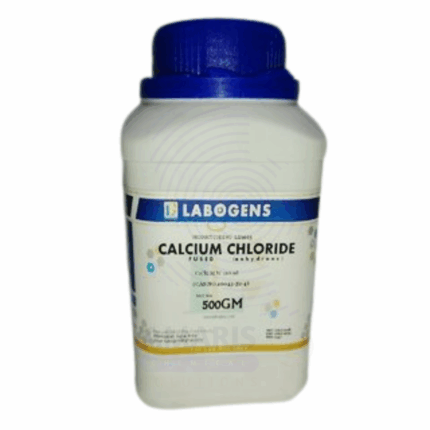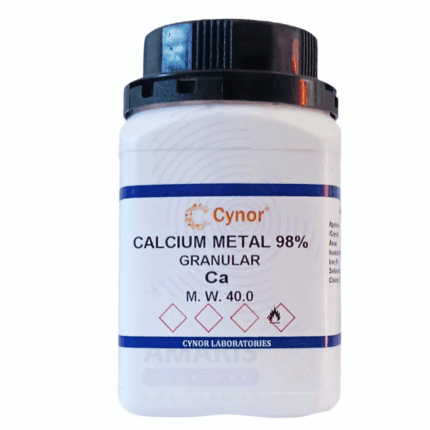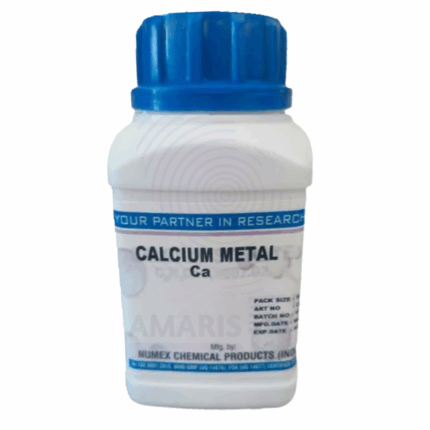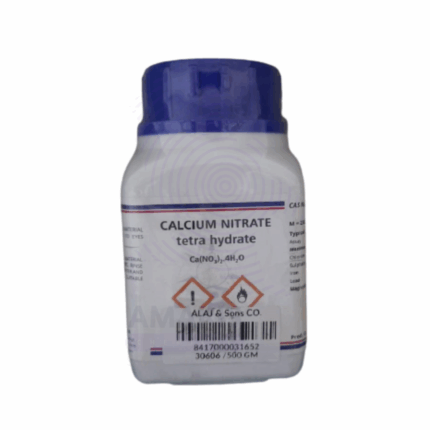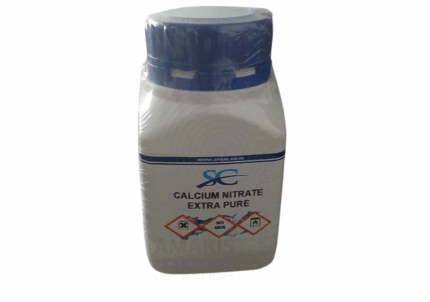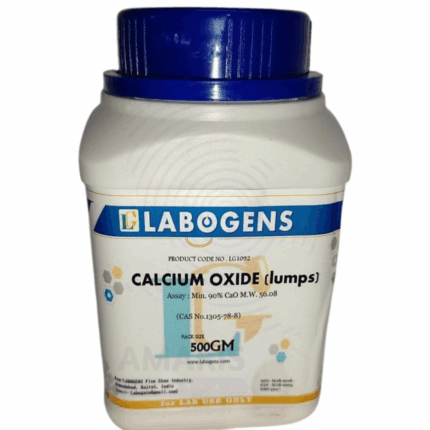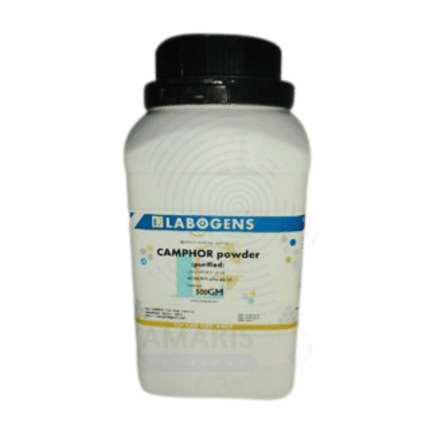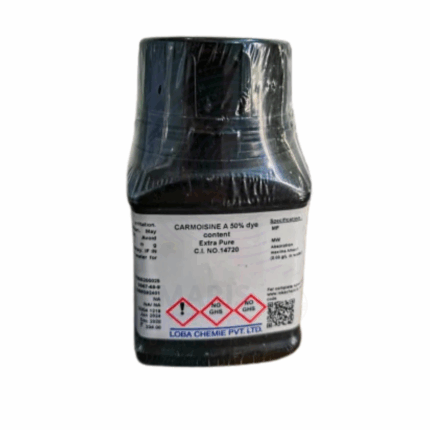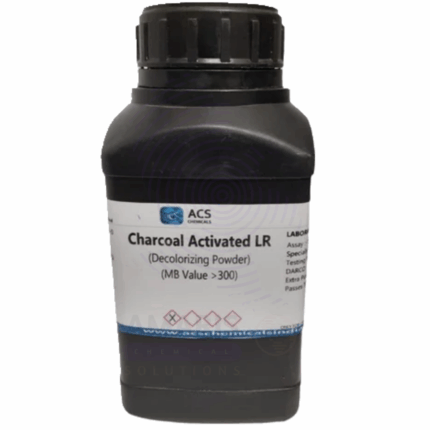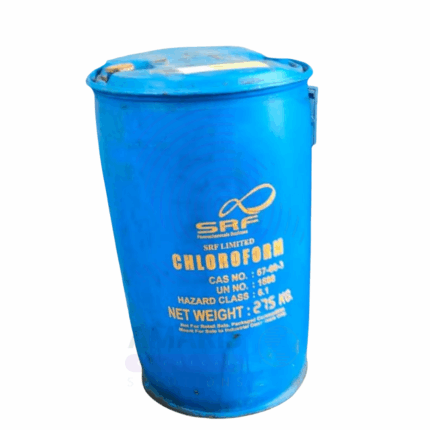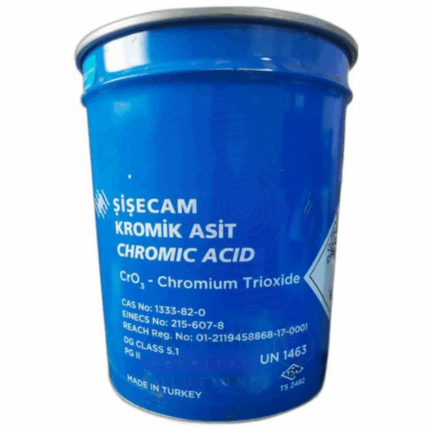
Basic Bismarck Mahogany Stain
Basic Bismarck Mahogany Stain is a high-quality wood stain formulated to impart a rich, warm mahogany hue to wooden surfaces. It enhances the natural grain of wood while providing long-lasting color and protection. Suitable for both interior and exterior applications, this stain penetrates deeply for durable, even coverage. It is widely used in woodworking, furniture finishing, and construction to achieve an attractive and classic mahogany finish.
Benedict Solution Extra Pure
Benedict Solution Extra Pure is a high-purity, blue-colored reagent solution widely used in laboratory settings for the qualitative detection of reducing sugars, such as glucose and fructose. It contains copper(II) sulfate, sodium citrate, and sodium carbonate, which react with reducing sugars under heat to form a colored precipitate ranging from green to brick red, depending on sugar concentration. This makes it essential in biochemical and educational laboratories for carbohydrate analysis and metabolic studies. The extra pure grade ensures consistent composition and reliable colorimetric response, supporting accurate and reproducible results in teaching and research environments. It should be stored in a cool, dark place in a tightly sealed container to maintain stability and prevent degradation.
Benzene Extra Pure
Benzene Extra Pure is a high-purity, clear, highly volatile, and flammable liquid with a characteristic aromatic odor, used extensively in laboratory settings for analytical, organic, and physical chemistry applications. It serves as a non-polar solvent for a wide range of chemical reactions, particularly in the study of aromatic compounds, electrophilic substitution mechanisms, and polymer chemistry. Its stability and solvency make it suitable for sample preparation, purification processes, and spectral analysis. The extra pure grade ensures minimal impurities, delivering consistent results in precision research. Due to its toxic and carcinogenic nature, benzene must be handled in a well-ventilated fume hood with appropriate protective equipment and stored in tightly sealed containers away from heat, sparks, and oxidizers.
Benzoic Acid Extra Pure
Benzoic Acid Extra Pure is a high-purity, white crystalline solid widely used in laboratory chemistry for analytical, organic, and preparative applications. It serves as a fundamental compound in the study of carboxylic acids, esterification reactions, and recrystallization techniques. Its well-defined melting point and chemical stability make it ideal for calibration and thermal analysis. Additionally, benzoic acid is commonly employed as a preservative standard and in pH-buffering studies. The extra pure grade ensures minimal contamination, offering reliability and accuracy in high-precision experiments. It should be stored in a cool, dry place in a tightly sealed container, away from strong oxidizers.
Benzyl Alcohol Extra Pure
Benzyl Alcohol Extra Pure is a high-purity, clear, colorless liquid with a mild aromatic odor, widely used in laboratory chemistry for analytical, synthetic, and preparative applications. It functions as a versatile solvent for inks, resins, waxes, and dyes, and plays a key role in organic synthesis, particularly in esterification and benzylation reactions. Its moderate polarity and low volatility make it valuable in sample preparation, chromatography, and pharmaceutical research. The extra pure grade guarantees minimal levels of impurities, ensuring reliable performance in high-precision laboratory procedures. Benzyl alcohol should be handled with care and stored in a tightly sealed container in a cool, dry place, away from strong oxidizing agents.
Beta Arbutin Extra Pure
Beta Arbutin Extra Pure is a high-purity, white crystalline powder primarily used in laboratory research involving biochemical, pharmaceutical, and cosmetic studies. It is a glycosylated hydroquinone known for its role as a tyrosinase inhibitor, making it significant in the investigation of melanin biosynthesis and skin depigmentation mechanisms. In pharmaceutical and cosmetic research, it is often evaluated for its antioxidant properties and potential therapeutic applications in skin-lightening formulations. The extra pure grade ensures high chemical stability and minimal impurities, supporting reliable results in sensitive assays and analytical procedures. It should be stored in a cool, dry environment, protected from light and moisture.
Bicarbonate Indicator Extra Pure
Bicarbonate Indicator Extra Pure is a high-purity, specially formulated solution used in laboratory settings to detect and monitor changes in bicarbonate ion concentration, particularly in biological and environmental experiments. It typically contains a pH-sensitive dye that changes color in response to shifts in carbon dioxide or bicarbonate levels, making it valuable in studies of respiration, photosynthesis, and water quality. This indicator is often employed in teaching labs to visually demonstrate gas exchange or acid-base balance. The extra pure grade ensures consistent performance, color clarity, and minimal background interference in precise analytical work. It should be stored in a cool, dark place in a tightly closed container to maintain its sensitivity and stability.
Bismuth Nitrate Extra Pure
Bismuth Nitrate Extra Pure is a high-purity inorganic compound composed of bismuth and nitrate ions, typically supplied as a crystalline solid or powder. It is widely used as a precursor in chemical synthesis, pharmaceuticals, cosmetics, and industrial applications. Known for its excellent solubility in nitric acid and water, this compound serves as a source of bismuth ions in various chemical reactions and formulations. Its high purity ensures minimal impurities, making it suitable for sensitive applications requiring consistent quality and performance.
Bitter Masking Pharmaceutical Liquid Flavors Extra Pure
Bitter Masking Pharmaceutical Liquid Flavors Extra Pure is a high-quality formulation designed to effectively mask unpleasant or bitter tastes in oral pharmaceutical preparations during laboratory research and development. This flavoring agent is essential in the compounding of liquid medications, syrups, and suspensions, particularly for pediatric and geriatric studies, where palatability is crucial for compliance. It is crafted to maintain chemical compatibility with active ingredients while preserving the stability and efficacy of the formulation. The extra pure grade ensures low impurity levels, consistent performance, and safety in sensitive pharmaceutical applications. It should be stored in a tightly sealed container, away from light and heat, to preserve its flavor integrity and quality.
Bitumen Primer Extra Pure
Bitumen Primer Extra Pure is a high-purity, low-viscosity liquid used in laboratory and industrial research involving adhesion studies, waterproofing technologies, and material compatibility testing. It consists primarily of refined bitumen dissolved in a suitable solvent, allowing it to penetrate and seal porous substrates like concrete, masonry, or metal. In laboratory contexts, it is used to study the behavior of protective coatings, surface treatments, and corrosion resistance. The extra pure grade ensures minimal impurities and uniform consistency, supporting accurate and reproducible test results. Bitumen Primer should be stored in a tightly closed container in a well-ventilated area, away from heat sources, sparks, and open flames
Bleaching Powder Extra Pure
Bleaching Powder Extra Pure is a high-purity, white to slightly yellowish powder composed primarily of calcium hypochlorite, widely used in laboratory settings for disinfection, oxidation, and chemical analysis. It serves as a strong oxidizing agent and is employed in qualitative tests for halogens, water treatment simulations, and preparation of chlorine-based reagents. In microbiology and environmental science labs, it is often used to sterilize surfaces and decontaminate samples. The extra pure grade ensures high available chlorine content and minimal impurities, making it reliable for precision applications. It should be stored in a cool, dry place, in airtight containers, away from moisture, organic substances, and acids to maintain its stability and reactivity.
Blue Color Water Soluble
Blue Color Water Soluble is a synthetic dye that dissolves readily in water, producing a vivid blue hue with excellent clarity and uniformity. It is widely used in textile dyeing, food and beverage coloring, cosmetics, pharmaceutical formulations, paints, and laboratory applications. The dye maintains stability across a broad pH range and provides consistent, bright coloration in aqueous systems. Its versatility makes it suitable for industrial, research, and commercial uses requiring a water-soluble blue pigment.
Borax Extra Pure
Borax Extra Pure, also known as sodium tetraborate decahydrate, is a high-purity crystalline compound widely used in laboratory applications involving buffer preparation, flame tests, and qualitative inorganic analysis. It serves as a valuable reagent in analytical chemistry for detecting metal ions, especially in borax bead tests, and is commonly used to prepare borate buffers for biochemical experiments due to its stable pH-regulating properties. Its ability to act as a mild alkali and complexing agent makes it suitable for various titration and solubility studies. The extra pure grade guarantees minimal contamination, ensuring accurate and consistent results in sensitive laboratory work. It should be stored in a tightly sealed container in a cool, dry environment, away from acids and moisture.
Boric Acid Extra Pure
Boric Acid Extra Pure is a high-purity, white crystalline powder commonly used in laboratory settings for analytical chemistry, buffer preparation, and microbiological applications. It acts as a mild acid and is frequently employed in the formulation of buffer solutions, particularly in electrophoresis and biochemical assays. In coordination chemistry and material science research, it is utilized as a source of boron and as a precursor for borate compounds. Its antifungal and antiseptic properties also make it useful in pharmaceutical and antimicrobial testing. The extra pure grade ensures excellent purity, low moisture content, and consistent performance in sensitive experimental conditions. It should be stored in a cool, dry place in tightly sealed containers, away from incompatible substances such as strong bases.
Bottle Weighing Plastic
The Bottle Weighing Plastic is a lightweight, durable container designed for accurate weighing and temporary storage of solids and powders in laboratory and industrial environments. Made from high-quality, chemical-resistant plastic, it ensures minimal interaction with samples during weighing and transfer procedures. Its sturdy construction resists cracking or deformation under typical laboratory use. This bottle is essential for precise measurement tasks requiring contamination-free handling and ease of cleaning.
Boyle’s Law Apparatus
Boyle’s Law Apparatus is a precision laboratory instrument designed to demonstrate and verify Boyle’s Law, which states that the pressure of a given mass of gas is inversely proportional to its volume at constant temperature. The apparatus typically consists of a sealed cylinder with a movable piston or syringe, pressure gauge, and volume scale, allowing students and researchers to observe and measure the relationship between pressure and volume in gases. It is widely used in educational and research laboratories to teach fundamental gas laws and perform experimental validation of theoretical principles.
Brilliant Blue Extra Pure
Brilliant Blue Extra Pure is a high-purity synthetic dye extensively used in laboratory research, particularly in biochemistry, molecular biology, and microbiology. It is commonly employed as a protein stain in techniques such as SDS-PAGE, where it binds to proteins for visualization and quantification. Additionally, it is used in spectrophotometric assays, as a pH indicator, and in dye tracing studies to monitor fluid movement or diffusion. The extra pure grade ensures consistent dye intensity, minimal impurities, and high solubility, making it ideal for precise analytical and experimental applications. It should be stored in a cool, dry environment, protected from light and tightly sealed to maintain its color integrity and stability.
Brilliant Green Extra Pure
Brilliant Green Extra Pure is a high-purity, intense green dye primarily used in microbiology and analytical laboratories for staining and selective microbial inhibition. It is especially effective in culture media to isolate specific bacterial strains, such as Salmonella spp., by suppressing the growth of gram-positive organisms. In addition to its antimicrobial role, it serves as a histological stain in biological research and is used in tracing, titration, and other colorimetric assays. The extra pure grade guarantees high dye content, minimal impurities, and excellent consistency, ensuring reliable results in sensitive and precise laboratory work. It should be stored in a tightly sealed container, away from direct light and heat, to preserve its stability and effectiveness.
Bromelain Extra Pure
Bromelain Extra Pure is a high-purity proteolytic enzyme derived from pineapple, widely used in laboratory research involving protein digestion, enzymatic reactions, and biochemical assays. It is particularly valued for its ability to hydrolyze a broad range of protein substrates, making it useful in studies of protein structure, enzyme kinetics, and tissue dissociation. In pharmaceutical and biomedical laboratories, it is also investigated for its anti-inflammatory, fibrinolytic, and mucolytic properties. The extra pure grade ensures minimal contamination from other enzymes or plant materials, offering consistent and reliable enzymatic activity. Bromelain should be stored in a cool, dry place in tightly sealed containers to maintain its stability and effectiveness.
Bromine Liquid Extra Pure
Bromine Liquid Extra Pure is a high-purity, reddish-brown volatile liquid used in advanced laboratory research involving halogenation reactions, redox studies, and analytical chemistry. It serves as a powerful oxidizing and brominating agent in organic synthesis, facilitating the substitution of hydrogen atoms with bromine in a wide range of compounds. In inorganic analysis, it is employed in the preparation of bromide salts and in the determination of unsaturation in oils and fats. Due to its high reactivity and corrosiveness, it is handled under strict safety protocols in fume hoods with appropriate protective equipment. The extra pure grade ensures minimal contamination and consistent reactivity, making it suitable for precise and high-sensitivity applications. It must be stored in tightly sealed, corrosion-resistant containers, away from heat, light, and incompatible materials such as organic solvents and reducing agents.
Bromine Water Extra Pure
Bromine Water Extra Pure is a highly purified aqueous solution of bromine, commonly used in laboratory settings for qualitative analysis, halogenation reactions, and redox studies. It acts as a powerful oxidizing and electrophilic brominating agent, making it ideal for detecting unsaturation in organic compounds—such as alkenes and alkynes—through decolorization tests. In inorganic chemistry, it is utilized for oxidation of specific ions and elements in solution. The extra pure grade ensures low contamination and consistent bromine concentration, crucial for reproducible analytical results. It should be stored in amber, airtight containers in a cool, well-ventilated area, and handled with proper protective equipment due to its corrosive and volatile nature.
Bromothymol Blue Extra Pure
Bromothymol Blue Extra Pure is a high-purity pH indicator dye widely used in laboratory experiments, especially in acid-base titrations and biological research. It exhibits a distinct color change from yellow in acidic solutions (pH < 6.0) to blue in basic conditions (pH > 7.6), making it valuable for monitoring pH changes in aqueous systems. This dye is also employed in respiratory experiments to detect CO₂ levels through pH shifts. The extra pure grade ensures excellent color stability, high sensitivity, and minimal impurities, making it suitable for precise analytical and educational applications. It should be stored in a tightly closed container, protected from light and moisture to maintain its integrity.
Butanoic Acid Extra Pure
Butanoic Acid Extra Pure, also known as butyric acid, is a high-purity carboxylic acid used in laboratory research for organic synthesis, esterification studies, and biochemical analysis. It serves as a building block in the preparation of esters, polymers, and pharmaceuticals, and is also studied for its role in metabolic and microbial pathways. With its strong, characteristic odor and reactive carboxyl group, it is valuable in reaction mechanism investigations and as a standard in acid-base titrations. The extra pure grade ensures low levels of moisture and contaminants, offering consistent performance in sensitive experiments. It should be handled in well-ventilated areas and stored in tightly sealed containers, away from heat and oxidizing agents.
Butanol Extra Pure
Butanol Extra Pure is a high-purity aliphatic alcohol commonly used in laboratory environments as a solvent, reagent, and intermediate in organic synthesis. Its moderate polarity and ability to dissolve a wide range of compounds make it ideal for use in extractions, chromatography, and spectrophotometric analysis. It also serves as a starting material for producing esters, plasticizers, and pharmaceuticals. The 99.4% purity ensures minimal water and impurity content, providing reliable consistency in sensitive procedures. With a relatively low evaporation rate and good miscibility with many organic solvents, it is suitable for both preparative and analytical applications. Proper storage in a cool, ventilated area in tightly sealed containers is essential to preserve its quality and reduce volatility.
Calamus Oil Extra Pure
Calamus Oil Extra Pure is a high-purity essential oil extracted from the roots of Acorus calamus, valued in laboratory research for its complex composition of aromatic compounds, including asarone and other volatile constituents. In scientific studies, it is often used for phytochemical analysis, antimicrobial testing, and natural product chemistry. Researchers explore its potential bioactive properties, such as antioxidant, neuroprotective, and insecticidal effects. The extra pure grade ensures high consistency, low residue, and minimal contamination, making it suitable for analytical applications. It should be stored in amber glass containers, away from light and heat, to preserve its stability and aromatic integrity.
Calcium Carbide Extra Pure
Calcium Carbide Extra Pure is a high-purity inorganic compound primarily used in laboratories for the generation of acetylene gas through hydrolysis, making it valuable for gas evolution experiments and flame tests. It is also utilized in organic synthesis reactions where acetylene is required as a precursor. The extra pure grade ensures minimal impurities, which is essential for consistent reaction performance and accuracy in analytical or instructional settings. Due to its high reactivity with water and release of flammable gases, it must be handled with care under dry conditions and stored in tightly sealed, moisture-resistant containers away from heat sources.
Calcium Carbonate Extra Pure
Calcium Carbonate Extra Pure is a high-purity, fine white powder widely used in laboratory settings as a buffering agent, a source of calcium ions, and a standard for acid-base titrations. It plays a key role in chemical analysis, gravimetric studies, and as a neutralizing agent in various reactions. In educational and research laboratories, it is also used to demonstrate decomposition reactions upon heating, releasing carbon dioxide and forming calcium oxide. The extra pure grade guarantees minimal impurities, making it suitable for precise analytical applications. It should be stored in tightly sealed containers in a dry environment to maintain its stability and reactivity.
Calcium Chloride Dihydrate Extra Pure
Calcium Chloride Dihydrate Extra Pure is a high-purity, white crystalline compound with the chemical formula CaCl₂·2H₂O. It is highly soluble in water and hygroscopic, making it effective as a drying agent, desiccant, and moisture absorber. This extra pure grade is suitable for laboratory use, analytical applications, and precise chemical processes where high-quality reagents are essential. It is also used in buffer solutions, preparation of calcium salts, and various industrial and environmental applications requiring controlled calcium ion concentrations.
Calcium Chloride Extra Pure
Calcium Chloride Extra Pure is a highly pure, hygroscopic compound widely used in laboratory applications as a desiccant, electrolyte source, and reagent in analytical chemistry. It is effective in moisture control, gas drying, and as a coagulant in biological and biochemical processes. Its strong affinity for water also makes it valuable in experiments involving freezing point depression, exothermic dissolution, and ionic reactions. The extra pure grade ensures minimal impurities, which is critical for accuracy in quantitative analysis, buffer preparation, and synthesis. It should be stored in well-sealed containers in a dry environment to prevent clumping and preserve its chemical performance.
Calcium Hyroxide Extra Pure
Calcium Hyroxide Extra Pure is a finely powdered, high-purity inorganic compound commonly used in laboratories as a strong base, pH adjuster, and reagent in qualitative and quantitative analysis. It is widely employed in acid-base titrations, preparation of limewater for carbon dioxide detection, and precipitation reactions involving metal ions. Its strong alkalinity also makes it useful in studying saponification, neutralization, and hydration processes. The extra pure grade ensures minimal impurities, making it suitable for sensitive analytical procedures and educational demonstrations. It should be stored in tightly sealed containers to prevent carbonation and moisture absorption, which can affect its chemical properties.
Calcium Nitrate Tetrahydrate Extra Pure
Calcium Nitrate Tetrahydrate Extra Pure is a crystalline, highly soluble laboratory-grade compound widely used as a source of calcium ions in analytical chemistry, solution preparation, and coordination studies. Its tetravalent hydrate form allows for controlled moisture content, making it ideal for reproducible experimental setups. This salt is frequently employed in qualitative tests for fluoride and carbonate ions, and in synthesis involving double displacement reactions. In teaching laboratories, it is also used to demonstrate solubility principles and endothermic dissolution behavior. The extra pure quality ensures minimal interference from contaminants, supporting high-precision research and reliable analytical results. It should be stored in a cool, dry environment to prevent caking and preserve its reactivity.
Calcium Oxide lumps Extra Pure
Calcium Oxide lumps Extra Pure is a high-purity, white to grayish solid commonly known as quicklime, widely used in laboratory settings for its strong basic and dehydrating properties. In analytical and preparative chemistry, it is utilized for drying organic solvents and gases, preparing calcium hydroxide solutions, and studying exothermic hydration reactions. Its reactive nature with water makes it ideal for demonstrations of heat evolution and chemical changes. The lump form provides a slower, controlled reactivity, especially useful in large-scale or prolonged experiments. The extra pure grade ensures consistent composition with minimal impurities, essential for precise scientific applications. It must be stored in airtight containers to prevent reaction with atmospheric moisture and carbon dioxide.
Calcium Sulphate Dihydrate Extra Pure
Calcium Sulphate Dihydrate Extra Pure is a high-purity, white crystalline compound commonly used in laboratory settings for controlled experiments involving hydration and crystallization. Also known as gypsum, it serves as a reliable source of calcium and sulfate ions in analytical chemistry and is often used in preparing culture media, setting-time studies, and thermogravimetric analysis. Its stable dihydrate form makes it ideal for demonstrating water crystallization and thermal decomposition when converted to hemihydrate or anhydrous forms. The extra pure grade guarantees minimal impurities, ensuring accuracy in sensitive applications. It should be stored in a cool, dry place to maintain its hydration state and analytical integrity.
Camphor Powder Extra Pure
Camphor Powder Extra Pure is a high-purity, crystalline white solid known for its distinct, penetrating aroma and volatility, making it valuable in laboratory applications involving sublimation, volatility studies, and organic compound identification. It is frequently used as a standard in melting point determination and as a model compound for exploring phase changes, vapor pressure, and diffusion behavior. In organic synthesis, it serves as a precursor or reagent in oxidation-reduction reactions. The extra pure grade ensures low impurity levels, which is essential for precise analytical and research work. Due to its flammable and volatile nature, it should be handled in well-ventilated areas and stored in tightly sealed containers away from heat and open flames.
Caprylic/Capric Acid Extra Pure
Caprylic/Capric Acid Extra Pure is a high-purity blend of medium-chain saturated fatty acids—primarily octanoic (caprylic) and decanoic (capric) acids—used in laboratory environments for studying lipid chemistry, esterification, and antimicrobial properties. Its dual-chain composition makes it valuable for investigating emulsion systems, fatty acid metabolism, and as a reference standard in chromatographic analysis. This acid mixture is also employed in the synthesis of esters, surfactants, and as a model compound in solubility and partition coefficient experiments. The extra pure grade ensures minimal contamination, supporting consistent and accurate results in biochemical and organic chemistry applications. It should be stored in a cool, dry place in tightly sealed containers to maintain stability and prevent oxidation.
Carbon Disulfide Extra Pure
Carbon Disulfide Extra Pure is a volatile, colorless to pale yellow liquid with a strong, characteristic odor, valued in laboratory settings for its high purity and solvency power. Commonly used as a non-polar solvent, it is ideal for dissolving sulfur, fats, resins, and phosphorus in analytical and synthetic chemistry. Its role extends to studying reaction kinetics, extraction processes, and as a reagent in organic synthesis involving thiocarbonyl compounds. Due to its low flash point and high volatility, it is also utilized in vapor pressure and flammability studies. The 99% extra pure grade ensures minimal impurities, critical for sensitive applications. It must be handled in a well-ventilated fume hood and stored away from heat, sparks, and oxidizing agents.
Carmine Aceto Extra Pure
Carmine Aceto Extra Pure is a high-purity, bright red dye derived from carminic acid, used extensively in laboratory applications involving histological staining, pH indicators, and biochemical assays. Known for its strong color stability in acidic environments, it is especially valuable in microscopy for highlighting cell structures and tissue components. Its precise formulation makes it suitable for use in analytical techniques requiring consistent coloration and minimal contamination. The extra pure grade ensures superior quality and reproducibility in experimental conditions. It should be stored in a cool, dry place, protected from direct light and moisture to preserve its dyeing efficacy and stability.
Carmoisine Red Extra Pure
Carmoisine Red Extra Pure is a high-purity synthetic azo dye widely used in laboratory settings for analytical and diagnostic applications, especially in colorimetric assays, pH studies, and chromatographic analysis. Known for its vibrant red hue and excellent solubility in water, it provides consistent and stable coloration under controlled conditions. In biochemical and pharmaceutical research, it serves as a model compound for dye interaction studies and compound tracing. The extra pure grade ensures low levels of impurities, offering high reliability in sensitive experimental work. It should be handled with care, stored in a cool, dry area, and protected from light to maintain its structural and color integrity.
Charcoal Decolourising Powder Extra Pure
Charcoal Decolourising Powder Extra Pure is a high-grade activated carbon used in laboratory settings for purification and clarification processes. Its exceptional adsorptive properties make it ideal for removing color impurities, organic contaminants, and unwanted residues from chemical solutions, solvents, and extracts. This extra pure form is especially suited for sensitive analytical work, pharmaceutical preparations, and biochemical applications where high purity and minimal contamination are critical. It is commonly used in filtration experiments and in the refinement of reagents and compounds. The powder should be handled in a dry environment and stored in airtight containers to maintain its effectiveness.
Chloroform
Chloroform (Trichloromethane) is a clear, colorless, volatile liquid with a sweet, pleasant odor. It is a widely used organic solvent with excellent solvency for many substances. Historically employed as an anesthetic, chloroform is now primarily used in laboratories and industry for extraction, degreasing, and chemical synthesis. It has moderate volatility and is heavier than air, requiring careful handling to avoid inhalation hazards. Its chemical stability and ability to dissolve fats, alkaloids, and other substances make it valuable in pharmaceutical, chemical, and industrial processes.
Chloroform Extra Pure
Chloroform Extra Pure is a high-purity, colorless, and volatile liquid commonly used in laboratory environments as a solvent, reagent, and extraction medium. Due to its excellent solvency for fats, alkaloids, and other organic compounds, it plays a key role in organic synthesis, chromatography, and sample preparation. In molecular biology, it is frequently used in nucleic acid extraction protocols. The extra pure grade ensures low levels of impurities, making it suitable for analytical and research applications that demand high accuracy. It must be handled with proper ventilation, protective equipment, and stored away from light and heat to prevent decomposition and formation of toxic by-products like phosgene.
Chromatogram paper
Product Description
Chromatogram Paper is a specialized high-quality absorbent paper used primarily in chromatography techniques for the separation and analysis of chemical substances. Manufactured to have consistent texture and porosity, it facilitates effective migration of solvents and analytes, allowing clear and reproducible chromatographic patterns. Widely utilized in laboratories for qualitative and quantitative chemical analysis, Chromatogram Paper is essential for research, quality control, and educational purposes.


 Preservatives(food)
Preservatives(food) Flavor Enhancers
Flavor Enhancers Acidulants
Acidulants Sweeteners
Sweeteners Antioxidants
Antioxidants Colorants(food)
Colorants(food) Nutraceutical Ingredients (food)
Nutraceutical Ingredients (food) Nutrient Supplements
Nutrient Supplements Emulsifiers
Emulsifiers
 Collectors
Collectors Dust Suppressants
Dust Suppressants Explosives and Blasting Agents
Explosives and Blasting Agents Flocculants and Coagulants
Flocculants and Coagulants Frothers
Frothers Leaching Agents
Leaching Agents pH Modifiers
pH Modifiers Precious Metal Extraction Agents
Precious Metal Extraction Agents
 Antioxidants(plastic)
Antioxidants(plastic) Colorants (Pigments, Dyes)
Colorants (Pigments, Dyes) Fillers and Reinforcements
Fillers and Reinforcements Flame Retardants
Flame Retardants Monomers
Monomers Plasticizers
Plasticizers Polymerization Initiators
Polymerization Initiators Stabilizers (UV, Heat)
Stabilizers (UV, Heat)
 Antifoaming Agents
Antifoaming Agents Chelating Agents
Chelating Agents Coagulants and Flocculants
Coagulants and Flocculants Corrosion Inhibitors
Corrosion Inhibitors Disinfectants and Biocides
Disinfectants and Biocides Oxidizing Agents
Oxidizing Agents pH Adjusters
pH Adjusters Scale Inhibitors( water)
Scale Inhibitors( water)
 Antioxidants(cosmetic)
Antioxidants(cosmetic) Emollients
Emollients Fragrances and Essential Oils
Fragrances and Essential Oils Humectants
Humectants Preservatives
Preservatives Surfactants(cosmetic)
Surfactants(cosmetic) Thickeners
Thickeners UV Filters
UV Filters
 Fertilizers
Fertilizers Soil Conditioners
Soil Conditioners Plant Growth Regulators
Plant Growth Regulators Animal Feed Additives
Animal Feed Additives Biostimulants
Biostimulants Pesticides (Herbicides, Insecticides, Fungicides)
Pesticides (Herbicides, Insecticides, Fungicides)
 Active Pharmaceutical Ingredients (APIs)
Active Pharmaceutical Ingredients (APIs) Excipients
Excipients Solvents(pharmaceutical)
Solvents(pharmaceutical) Antibiotics
Antibiotics Antiseptics and Disinfectants
Antiseptics and Disinfectants Vaccine Adjuvants
Vaccine Adjuvants Nutraceutical Ingredients (pharmaceutical)
Nutraceutical Ingredients (pharmaceutical) Analgesics & Antipyretics
Analgesics & Antipyretics
 Analytical Reagents
Analytical Reagents Solvents(lab)
Solvents(lab) Chromatography Chemicals
Chromatography Chemicals Spectroscopy Reagents
Spectroscopy Reagents microbiology-and-cell-culture-reagents
microbiology-and-cell-culture-reagents Molecular Biology Reagents
Molecular Biology Reagents Biochemical Reagents
Biochemical Reagents Inorganic and Organic Standards
Inorganic and Organic Standards Laboratory Safety Chemicals
Laboratory Safety Chemicals Specialty Laboratory Chemicals(Special Laboratory Equipment)
Specialty Laboratory Chemicals(Special Laboratory Equipment)
 Demulsifiers
Demulsifiers Hydraulic Fracturing Fluids
Hydraulic Fracturing Fluids Scale Inhibitors(oil)
Scale Inhibitors(oil) Surfactants(oil)
Surfactants(oil) Drilling Fluids
Drilling Fluids
 Dyes and Pigments
Dyes and Pigments Bleaching Agents
Bleaching Agents Softening Agents
Softening Agents Finishing Agents
Finishing Agents Antistatic Agents
Antistatic Agents
 Admixtures
Admixtures Waterproofing Agents
Waterproofing Agents Sealants and Adhesives
Sealants and Adhesives Curing Compounds
Curing Compounds Concrete Repair Chemicals
Concrete Repair Chemicals Anti-Corrosion Coatings
Anti-Corrosion Coatings
 Surfactants(cleaning)
Surfactants(cleaning) Builders
Builders Enzymes
Enzymes Solvents (Cleaning)
Solvents (Cleaning) Fragrances
Fragrances
 Electronic Chemicals
Electronic Chemicals Catalysts
Catalysts Lubricants
Lubricants Photographic Chemicals
Photographic Chemicals Refrigerants
Refrigerants Automotive chemicals
Automotive chemicals Pyrotechnic Chemicals
Pyrotechnic Chemicals
 Biodegradable Surfactants
Biodegradable Surfactants Bio-based Solvents
Bio-based Solvents Renewable Polymers
Renewable Polymers Carbon Capture Chemicals
Carbon Capture Chemicals Wastewater Treatment Chemicals
Wastewater Treatment Chemicals
 Pigments
Pigments Solvents(paint)
Solvents(paint) Specialty Coatings
Specialty Coatings Binders/Resins
Binders/Resins Additives
Additives Driers
Driers Anti-Corrosion Agents
Anti-Corrosion Agents Functional Coatings
Functional Coatings Application-Specific Coatings
Application-Specific Coatings
 Fresh Herbs
Fresh Herbs Ground Spices
Ground Spices Whole Spices
Whole Spices Spice Blends
Spice Blends Dried Herbs
Dried Herbs
 Leavening Agents
Leavening Agents Dough Conditioners
Dough Conditioners Flour Treatments
Flour Treatments Fat Replacers
Fat Replacers Decoratives
Decoratives Preservatives(baking)
Preservatives(baking)
 Plasticizers & Softeners
Plasticizers & Softeners Reinforcing Agents
Reinforcing Agents Adhesion Promoters
Adhesion Promoters Vulcanizing Agents
Vulcanizing Agents Antidegradants
Antidegradants Blowing Agents
Blowing Agents Fillers & Extenders
Fillers & Extenders Accelerators & Retarders
Accelerators & Retarders
